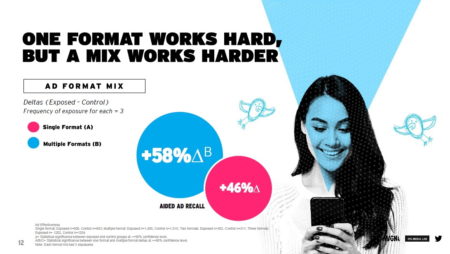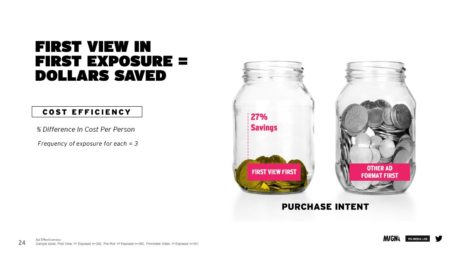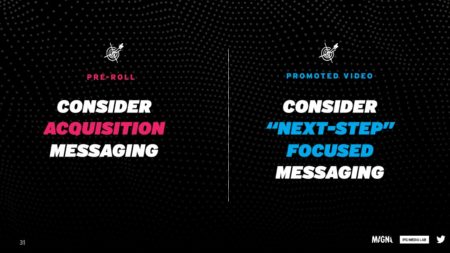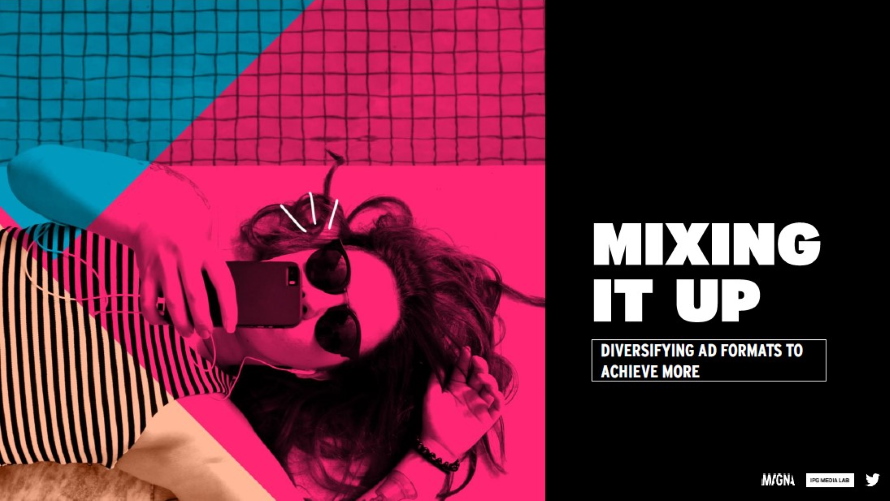Should advertisers with fixed budgets spend more money on a single ad format, or should they spread their budgets across multiple formats? Twitter teamed up with Magna and IPG Media Lab on a study to answer that very question.
The social network and the two IPG Mediabrands units said the results of “Mixing It Up: Diversifying Ad Formats to Achieve More” demonstrated that the use of multiple formats in digital advertising can help brands better tell their stories and boost awareness, brand favorability, research intent and purchase intent.
Research was done in two parts: An eye-tracking analysis with 69 Twitter users who visited Magna’s lab in San Francisco and donned eye-tracking glasses, and an ad-effectiveness analysis with some 4,000 Twitter users participating on mobile devices across three ad types: preroll (dubbed Amplify on Twitter), traditional promoted video and First View (a one-day takeover of the standalone video ad atop the feed).
The test was conducted across six industry verticals and 136 different ad scenarios, and key findings included:
- A mix for better storytelling: The three companies said seeing an ad in a variety of visually different contexts makes it stand out more, leading to six times the impact on research intent, doubling the impact on purchase intent, boosting ad recall by 58% (versus 46% for ads in a single format) and seeing 61% of participants say the ad stood out among other tweets (compared with 51%).

- First impressions count: The first exposure should be the one that grabs the most attention, and Twitter’s First View format proved to be 27% more cost-efficient at impacting purchase intents than when other formats were used first.

- Leverage unique strengths: First View generated mass attention, while preroll and promoted video used together drive new consumers and past buyers through the purchasing journey. The three companies said preroll leads to 8% jumps in new product awareness and research intent, while past buyers are 14% more likely to complete promoted videos. The latter also boosts awareness of cultural connections by 18% and lifts positive brand perceptions by 9%.

Twitter head of global business partners Stephanie Prager said in a statement, “When you’re building a campaign, you’re trying to tell the best, most impactful and most accessible story possible. Our research validates that at its best, storytelling isn’t just about the message: It’s also about the method. We hope this encourages advertisers to continue exploring and experimenting with the different surfaces and formats for their messages that live within digital platforms like Twitter.”
Magna senior vice president of intelligence solutions Kara Manatt added, “For a long time, many brands thought it made sense to put a majority of their budget into an ad format that worked for them, but our study’s findings are a major differentiator because it indicates that a mix works better at driving awareness, purchase intent and brand favorability. Creating this sort of variation in ad experiences doesn’t necessarily require creating a whole host of new assets. In our study, the same exact ad led to better results when presented differently.”

